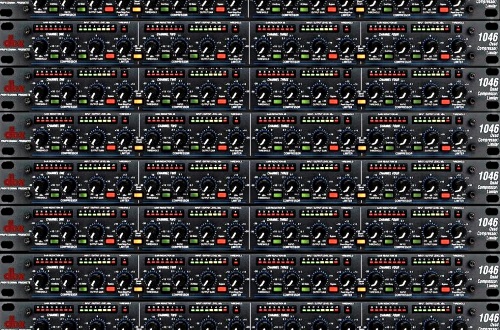
To begin with, even a small monitor mix can justify eight compression channels. As mentioned above, keyboard signals must be managed at all cost, plus kick and snare drums and bass have to be rock solid in the stage monitors. Past that, the hard screaming vocalist requires compression and possibly limiting for sanity and safety. And some discrete mix sends may require a limiter to maximize dB SPL through the performance.
At FOH we’ll channel-insert a compressor channel on each drum channel, so we may need as many as 10-channels from drums alone. Bass, lead and rhythm guitars can certainly eat up 3 or 4 channels, and depending on the number of singers another 4-channel unit could be dedicated to vocals. Finally, assuming there are keyboards, each stereo keyboard requires two compressor channels or four total. So, we have used at least 20-22 of our 24-channels for channel inserts alone and could use the remaining channels on any other instrument—sax or harmonica, for example.
Of course you don’t have to use compressors only as channel inserts. Most large consoles feature submix groups where, depending on what is assigned to them, compressor-inserts can smooth large sections of your mix.
For example, even an act with compression inserted on each backing vocalists’ channel could benefit from a grouped vocal submix using an inserted compressor at about 3 or 4:1 ratio. By judiciously increasing the input level the compressor will grab those soaring harmonies tie them together and push them up front. The same is true for a horn section. A final touch is to gate that sub-group to maximize clarity.
Conclusion
Like most audio skills the key is practice, practice, practice. Specifically, know what you’re trying to do with compression and why. Have a plan. Decide what audio channels are most in need of your available compression. Assume that vocals and drums have a smaller acceptable margin for drifting in the mix than guitars or keyboards and act accordingly. Aggressively manage input signals so the compressor can function at robust levels (neither too weak or too strong).
Pay strict attention to the compressors LEDs to get a visual fix during rehearsal and sound check of where the optimum adjustments are. Remember that on average a 3 dB difference in relative levels is required for one sound to seem louder than another. Sensitize yourself to the way one sound masks another and use that knowledge when applying compressors. And continue to twiddle those knobs and get a better, fatter sound happening right now.
— Sidebar —
Compressor/Limiter Basics
Compressors are an invaluable form of artificial audio intelligence. They make decisions about program material and respond accordingly as a variable gain amplifier. As opposed to a linear gain amplifier. So while linear gain amplifiers amplify signal at a 1 to 1 ratio (1:1), so that each dB increase of input results in a 1 dB of output gain increase of output Dynamic range is the difference in dB between an audio program’s highest and lowest volume levels. The compression function is used to reduce dynamic range so that the difference between peak audio signal and the lowest part of the program shrinks.
In live sound reinforcement, compression is used to shrink or squeeze any audio signal so it can successfully fit into the artistic requirements and technical realities of the program. Add ratios. The limiting function of a compressor/limiter only takes places after the audio signal has reached a certain level called threshold. The limiter function is generally thought to take place at a 10:1 ratio or higher. Its like putting a brick wall on the top end of an audio system or sub-system.
Threshold settings are usually user-selectable. Limiters allow the downward dynamics of a program to remain unaltered while peak signal output is limited. In music reinforcement this means that the natural volume of an instrument is not simultaneously amplified at its peak to produce unnatural dynamics or, even worse threaten system components. This adds a transparency to the device. The uses for these devices extends through channel inserts, crossover outputs and console and monitor main outs. It should be remembered low frequency sources such as kick drums and bass guitar are often heard as the “loudest” by the compressor and may force an unnatural HF signal on the overall mix.
While this column specifically deals with amplified music and voice, compression and limiting is especially useful throughout the live performance industry.
For example, there is no way to mix reinforcement for a Broadway musical or a big time corporate presentation without effective use of compressor technology. It makes it look easy.
Duncan Fry is a long-time audio professional based in Australia and is the author of Live Sound Mixing (4th Edition).
